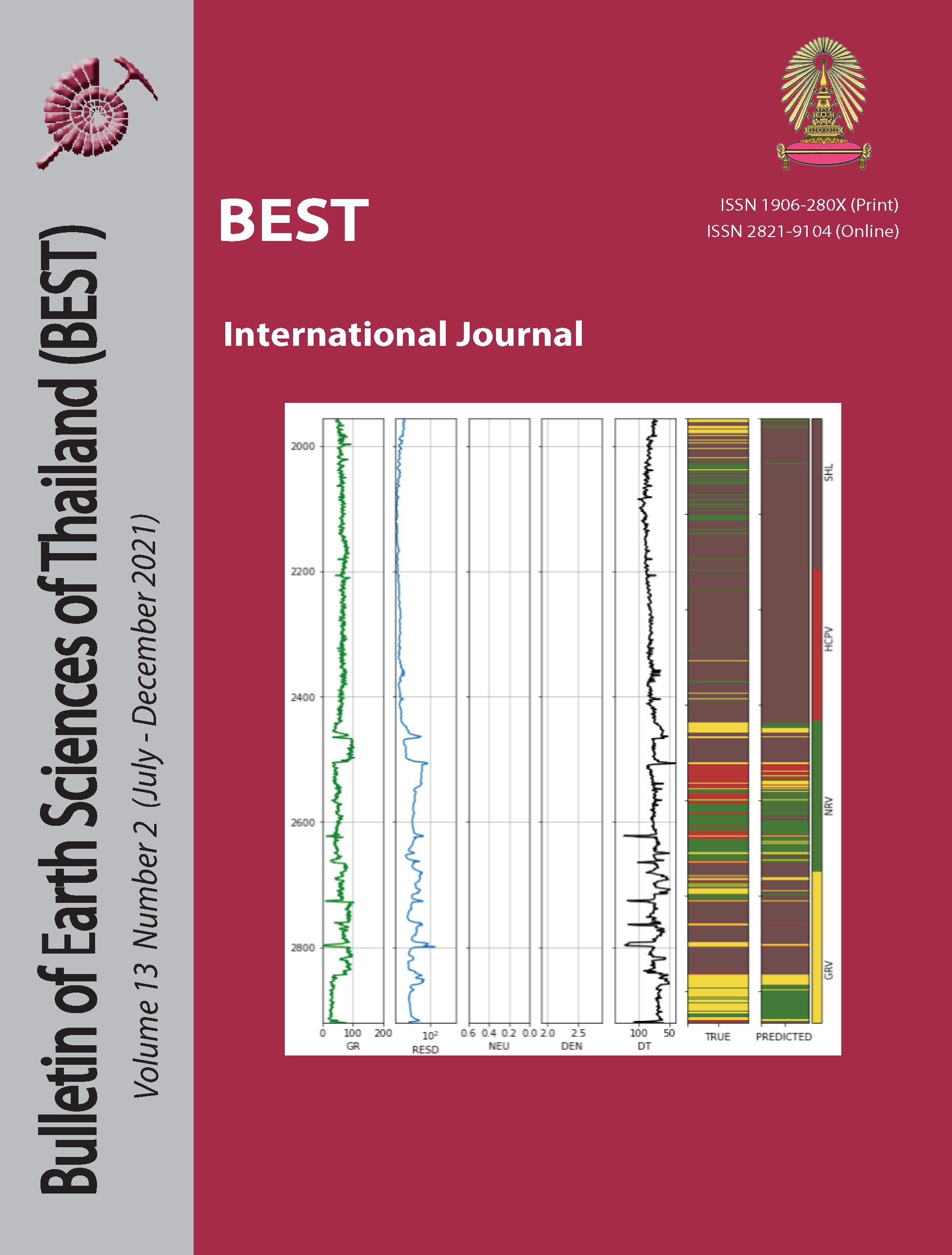Fracture characterization and basement reservoir potential of Phra Wihan Formation in southern part of Uttaradit Province, Northern Thailand
Main Article Content
Abstract
This paper describes the characterization of fractures in the Mesozoic sandstones Phra Wihan Formation exposed at the southern part of Uttaradit province, Northern Thailand. Fracture characterization of outcrop analog is important to determine potential of subsurface reservoir. The methodology used in this study includes field study and petrographical analysis to determine the relationship between fractures and other structures such as bedding plane and fold geometry. In addition, microstructural analysis is performed to evaluate the potential of reservoir. The Phra Wihan Formation composed of thick quartz arenite sandstone laminated with mudstones. Based on outcrop study, the structural architectures consist of two orthogonal open fracture sets dominated in the fold limb. The first fracture set (Set I) is subdivided into Set Ia and Set Ib, developed in WNW-ESE direction perpendicular to the fold axial plane and parallel to the major compression stress. The second fracture set (Set II) is subdivided into Set IIa and Set IIb, developed in NNE-SSW direction parallel to the fold axial plane. These fractures imply to be associated with folding stage related to WNW-ESE compression stress during India-Eurasia collision.
Article Details

This work is licensed under a Creative Commons Attribution-NonCommercial-NoDerivatives 4.0 International License.
Copyright © 2008 Department of Geology, Faculty of Science, Chulalongkorn University. Parts of an article can be photocopied or reproduced without prior written permission from the author(s), but due acknowledgments should be stated or cited accordingly.
References
C&C Reservoirs, 2009. Field evaluation report of Sirikit field, Reservoir Architecture, Phitsanulok basin, Thailand, p. 5-7.
Department of Mineral Resources, 2007, Geological maps of Changwat Uttaradit. Scale 1:50,000. Department of Mineral Resources, Bangkok.
Meissner, F. F. & Thomasson, M. R., 2001. Exploration opportunities in the Greater Rocky Mountain Region, U.S.A. In: Downey, M. W., Threet, J. C., & Morgan, W. A. (eds) Petroleum Provinces of the 21st Century. AAPG, Tulsa, Memoir, v. 74, p. 201–240.
Morley, C. K., 2002, A tectonic model for the Tertiary evolution of strike–slip faults and rift basins in SE Asia. Tectonophysics, v. 347, p. 189– 215
Morley, C. K., 2004, Nested strike-slip duplexes and other evidence for Late Cretaceous-Paleogene transpressional tectonics before and during India-Eurasia collision, in Thailand, Myanmar and Malaysia. Journal Geol. Soc. London, v. 161, p. 799-812.
Morley, C.K., 2012, Late Cretaceous-Early Palaeogene tectonic development of SE Asia. Earth-Science Review, v. 115, p. 37-75.
Sha, J.-G., & Meesook, A., 2013, Non - Marine Cretaceous Bivalve Biostratigraphy of Thailand and Southern Lao PDR. The 2nd Lao-Thai Technical Conference on Geology and Mineral Resources, Lao PDR, January 17-18, p. 47 – 69
Sone, M., & I. Metcalfe., 2008, Parallel Tethyan sutures in mainland Southeast Asia: New insights for Palaeo-Tethys closure and implications for the Indosinian orogeny. ScienceDirect, p. 166-179.
Thitipattanakul, T., Benjawan T., Prachukbunchong P., Inraikhing K., & Krisadasima S., 2018, A Basement Play In Mature Sirikit Oilfield, Phitsanulok Basin, AAPG Asia Pacific Region GTW, Back to the Future – The Past and Future of Oil and Gas Production in the Asia Pacific Region, Bangkok, Thailand, September 26-27.


